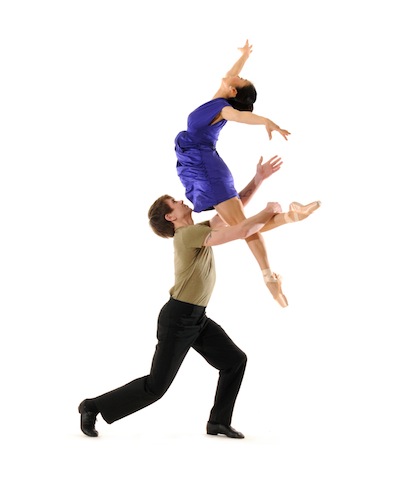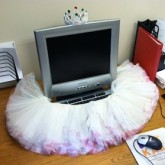Hundreds of submissions are being considered.
If you used the Twitter hashtag #DiabloWebBallet to suggest your choreographic ideas before Valentine’s Day, yours is among them and could be one of seven used to create Diablo Ballet’s new “Web Ballet.”
Throughout my 5 years as a dance writer and blogger, I’ve witnessed plenty of choreographer experimentation with the social medium. This is the first time I’ve encountered an Internet audience collaboration which will result in a fully-staged ballet work. Not surprisingly, this project comes from Diablo Ballet, a small, California-based ballet company that’s taking big strides in step with a big mission: to make dance more accessible to everyone, including the online audience.

Diablo dancer and founder of San Francisco’s Post:Ballet dance company, Robert Dekkers, will choreograph the ballet in time for its March 1st premiere, less than two weeks away. Still, Robert took some time this weekend to talk with us about The Web Ballet project and his development and process as a choreographer.
Dance Advantage: How was the idea of doing a “web ballet” presented to you? And what was your initial reaction?
Robert Dekkers: The concept started with an activity Diablo Ballet regularly does during outreach performances where audiences are asked to choose a setting, character, and title for a new ballet. The piece is quickly constructed and, using live music, the two dancers act out the new ballet — always to the audience’s amusement!
Dan [Meagher, Diablo Ballet’s marketing director] thought it would be fun to recreate the experience online, and so Lauren [Jonas, co-founder and Artistic Director] approached me and asked if I’d be interested in participating. I was immediately interested in the project, but wanted to discuss it further before committing.
I was eager for people to submit choreographic limitations that would define my creative path as the choreographer, and after we met to brainstorm about the project we decided to blend these two ideas together and solicit suggestions of any type; mood, specific steps, thematic concept, rules for the dancers to follow. We suggested emotional state, mood and dance moves to get people’s gears turning. I look forward to selecting a final group of seven ideas to incorporate into the new piece.
DA: Do the ‘question marks’ scare you just a little bit?
RD: Honestly, I am more scared that people won’t submit enough out-of-the-box ideas, which is what I’m looking for. I want dance aficionados and novices alike to be a part of this process, so even if someone isn’t knowledgeable about dance, I want their idea! I’ve had lots of non-dance friends tell me their ideas for a dance piece. We wanted anyone who has ever thought “they should do this!” during a dance performance to speak up.
DA: Are you able to do any choreographic or mental preparation, or will the starter gun just go off in your head when the winning submissions are selected?
RD: I am trying not to do too much prep work so as not to steer the piece in a particular direction before submissions are selected. However, I am definitely thinking a lot about limitations, both self and externally imposed, and think that this concept will probably be present in one way or another in the work since it’s so integral to the entire process. Limitations can restrict us, but they can also provide direction and the opportunity to look at things in a different light.
I also know that the piece will include seven dancers and will be set to one of three pieces of music, so that helps my thought process. Regarding the musical selections, I selected these three pieces of music because I choreographed to each of them when I first started creating work.
When I was younger, my choreography was very balletic, I didn’t stray far from the classical movement vocabulary or musical selections, but over the years my work has developed into what some would call “modern ballet.” I still work with classically trained dancers and utilize this technique, but my movement sensibilities and conceptual creative approach is more closely aligned with modern dance. I’m interested to see how I reuse one of these pieces of classical music to create something entirely different!
 DA: It’s been said that audience expectations of creators have changed; that they expect conversation, or its equivalent, not lecture. What do you think?
DA: It’s been said that audience expectations of creators have changed; that they expect conversation, or its equivalent, not lecture. What do you think?
RD: It’s true, we are no longer content to be simple observers, we want to participate! A recent exhibit at San Francisco Museum of Modern Art featured Rafael Lozano-Hemmer’s 2003 work “Frequency and Volume,” which actively engaged viewers to create the artwork using their own bodies. The piece was a great example of how artists are actively engaging their audiences to make work that is relevant and relatable.
DA: You regularly create new work for your company Post:Ballet. I’m inferring that the company’s name has some relationship to the term postmodern. What does “postballet” mean to you?
RD: You are totally right on with your inference. As a classically trained dancer and choreographer who’s fascinated with modern art, I have been questioning more and more the direction that ballet is going. Neoclassical ballet and contemporary ballet are both terms that now define a specific aesthetic and time period, and I’m really interested in what’s happening today, right now. Post is what comes after, and that’s where I want my company and my work to be. On the cutting edge, never complacent and always eager to challenge the status quo and express the voice of today.
DA: From where does your inspiration for new work typically come?
RD: My inspiration to create is never the same twice. Sometimes I’m inspired by a mathematical principle or scientific theory, sometimes I want to make an observation about a particular social situation or topic, and sometimes it’s the dancers and collaborators who initially inspire me. Wherever the inspiration comes from for a particular piece, I find that my work always ends up evolving into something very personal and connected to my own life and experiences.
DA: When did you first begin to think of yourself as a choreographer?
RD: [Laughing] I made up dance routines for my neighbors and myself all the time when I was a kid — true confession — and started making dance pieces for the stage when I was 16. About five years ago, I feel like my choreography began to shift from “making pieces” to actually creating work that had glimmers of originality and substance. Every time I create a new work I learn and grow from the experience, so maybe in another decade I’ll be able to call myself a choreographer!
DA: Throughout your early experimentation with choreography, what were the experiences that most helped you develop your skills or craft?
RD: Having so many opportunities to work on my craft of choreography over the years has really helped me strengthen my skills. I started by creating works on pre-professional students and then began to choreograph short pieces for professional dancers to perform at ballet competitions or festivals.
After I was given an opportunity to present a work at the Ballet Builders Showcase in NYC using Ballet Arizona dancers — I was dancing in the company there at the time — I was invited to create a new work on Novaballet, a contemporary company based in Phoenix. The following year they invited me to create two more new works for the company as Resident Choreographer, and the year after, I decided to start Post:Ballet so that I could push myself further as an artist and work with a diverse group of collaborators on the development of new and innovative work.
There have been many incredible opportunities along the way, and so many wise and gracious mentors who have taught me so much. I look forward to continuing to develop my skills and grow as a choreographer for decades and decades to come.
DA: How does your role as a choreographer affect your process as a dancer, and visa versa?
RD: My natural movement qualities certainly influence my work as a choreographer, but I try to provide opportunities for the dancers to be creative as well, so that their own movement sensibilities are incorporated into a work. This gives the dancers a sense of ownership and allows each piece to develop a uniqueness inspired by the particular dancers involved.
As a dancer, my choreographic viewpoint definitely has a clear influence on my movement, but I always try to be respectful when working with another choreographer as I want them create the work that they are envisioning, not one that I might be seeing!
Some choreographers encourage dancers to explore their movement and interpret it in their own way, while others have a very clear idea of what they are looking for aesthetically and prefer for dancers to perform the choreography exactly as it’s given. Every choreographer’s stance on this matter is slightly different.
I find that I am somewhere in the middle; I want the dancers to maintain the specifics of my work while exploring the in between moments and finding ways to express the movement organically. As I gradually shift from a dancer to a choreographer, I will be interested to see how my work continues to develop and change. I hope that I’ll be able to maintain my unique sense of movement while collaborating with the dancers in an ever greater capacity.
The Web Ballet will be performed March 1 and 2, 2013 as part of Diablo Ballet’s Inside The Dancer’s Studio. Diablo Ballet will announce the seven winning submissions tomorrow, so stay tuned to their Twitter or Facebook page for the news!
As an audience member, have you ever been a participant in the choreographic process?
What are some other ways choreographers could use the Internet or technology to make dances?
Nichelle Suzanne is a writer specializing in dance and online content. She is also a dance instructor with over 20 years experience teaching in dance studios, community programs, and colleges. She began Dance Advantage in 2008, equipped with a passion for movement education and an intuitive sense that a blog could bring dancers together. As a Houston-based dance writer, Nichelle covers dance performance for Dance Source Houston, Arts+Culture Texas, and other publications. She is a leader in social media within the dance community and has presented on blogging for dance organizations, including Dance/USA. Nichelle provides web consulting and writing services for dancers, dance schools and studios, and those beyond the dance world. Read Nichelle’s posts.

